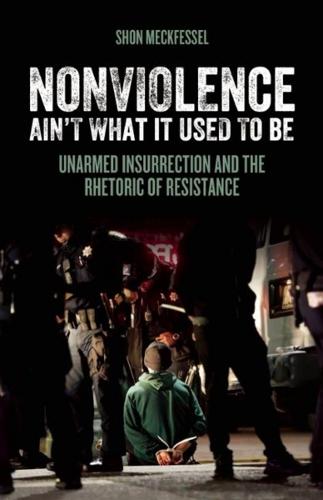 We are halfway through Nonviolence Ain’t What It Used to Be before Shon Meckfessel clarifies what his title is about.
We are halfway through Nonviolence Ain’t What It Used to Be before Shon Meckfessel clarifies what his title is about.
Along the way, he refers to postmodernists such as Deleuze and Althusser and sprinkles in words like ‘materiality’, ‘imaginary’ (as a noun) and ‘profanation’.
The main purpose of the book is to justify ‘counterhegemonic’ rioting. There are chapters on the ‘eloquence’ of public property destruction and of clashing with the police.
Meckfessel writes, finally, that US authors Chris Hedges, Rebecca Solnit and Todd Gitlin labelled rioters as the ‘cancer’ in the US Occupy movement, and that some Occupy activists labelled other Occupy activists as ‘violent’. (p106) He asks: ‘Where had these voices come from in the first place, and how had they become so different from nonviolence proponents in the past?’ (He doesn’t answer these questions.)
So ‘nonviolence today’ is the anti-rioting critique of Hedges and others.
It turns out that ‘what nonviolence used to be’ is what Meckfessel calls the ‘classic’ or ‘traditional’ nonviolence of Gandhi and King.
Meckfessel claims that there has been a ‘slippage of “nonviolence” from a means of conflict with power to an excuse to avoid it’. (p39)
But he also admits in a footnote that ‘the very title of this book might be rather misleading – perhaps nonviolence never was what it used to be, and neither was armed struggle’. (p65) Which suggests that he should have re-thought the book before publishing it.
There is a lot of confusion running through the text, and some unreality. One of Meckfessel’s main claims is that today, unlike in Gandhi or King’s time, there are no cameras willing to convey images of nonviolent ‘sacrifice’ to a mass audience, and that is why nonviolence is now ineffective.
Meckfessel’s analysis of the mass media today is central to his argument, but he shows no sign of ever having heard of Chomsky’s Propaganda Model of the media. Weird.
I also wish he’d read Barbara Deming’s ‘On Revolution and Equilibrium’ and ‘On Anger’, classics of revolutionary nonviolence that engage with activists who support using injurious force.
Meckfessel has read widely and assembled interesting, though undigested, material. For most activists, though, I suspect it won’t be worth the effort of wading through this ambitious, pretentious and chaotic attempt to add something new to the violence-nonviolence debate.


